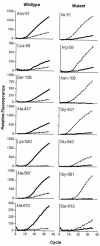Rapid real-time PCR genotyping of mutations associated with sulfadoxine-pyrimethamine resistance in Plasmodium falciparum
- PMID: 15273102
- PMCID: PMC478490
- DOI: 10.1128/AAC.48.8.2924-2929.2004
Rapid real-time PCR genotyping of mutations associated with sulfadoxine-pyrimethamine resistance in Plasmodium falciparum
Abstract
The resistance of Plasmodium falciparum to sulfadoxine-pyrimethamine (SP) is an emerging public health threat. Resistance to these drugs is associated with point mutations in the genes encoding dihydropteroate synthase (DHPS) and dihydrofolate reductase (DHFR). We describe here an assay using real-time PCR and sequence-specific probes that detects these mutations. Using DNA from plasmids, cultured strains, and clinical samples, real-time PCR could distinguish four DHPS polymorphisms (codons 437, 540, 581, and 613) and three DHFR polymorphisms (codons 51, 59, and 108). This assay is rapid and sensitive, with a detection limit of 10 copies in most cases. This assay is amenable to large-scale studies of drug resistance.
Figures



Similar articles
-
Prevalence of sulfadoxine-pyrimethamine resistance-associated mutations in dhfr and dhps genes of Plasmodium falciparum three years after SP withdrawal in Bahir Dar, Northwest Ethiopia.Acta Trop. 2013 Dec;128(3):636-41. doi: 10.1016/j.actatropica.2013.09.010. Epub 2013 Sep 18. Acta Trop. 2013. PMID: 24055717
-
Mutations in Plasmodium falciparum dihydrofolate reductase and dihydropteroate synthase and epidemiologic patterns of pyrimethamine-sulfadoxine use and resistance.J Infect Dis. 1997 Dec;176(6):1590-6. doi: 10.1086/514159. J Infect Dis. 1997. PMID: 9395372
-
Validation of a simplified method for using molecular markers to predict sulfadoxine-pyrimethamine treatment failure in African children with falciparum malaria.Am J Trop Med Hyg. 2003 Sep;69(3):247-52. Am J Trop Med Hyg. 2003. PMID: 14628939 Clinical Trial.
-
Ordered accumulation of mutations conferring resistance to sulfadoxine-pyrimethamine in the Plasmodium falciparum parasite.J Infect Dis. 2014 Jan 1;209(1):130-9. doi: 10.1093/infdis/jit415. Epub 2013 Aug 6. J Infect Dis. 2014. PMID: 23922363
-
Sulfadoxine-pyrimethamine resistance in Plasmodium falciparum: a zoomed image at the molecular level within a geographic context.Acta Trop. 2013 Feb;125(2):163-90. doi: 10.1016/j.actatropica.2012.10.013. Epub 2012 Nov 3. Acta Trop. 2013. PMID: 23131424 Review.
Cited by
-
Temporal trends of sulphadoxine-pyrimethamine (SP) drug-resistance molecular markers in Plasmodium falciparum parasites from pregnant women in western Kenya.Malar J. 2012 Jul 4;11:134. doi: 10.1186/1475-2875-11-134. Malar J. 2012. PMID: 22540158 Free PMC article.
-
High-throughput genotyping of single nucleotide polymorphisms in the Plasmodium falciparum dhfr gene by asymmetric PCR and melt-curve analysis.J Clin Microbiol. 2010 Sep;48(9):3081-7. doi: 10.1128/JCM.00634-10. Epub 2010 Jul 14. J Clin Microbiol. 2010. PMID: 20631115 Free PMC article.
-
Molecular Epidemiology of Plasmodium falciparum kelch13 Mutations in Senegal Determined by Using Targeted Amplicon Deep Sequencing.Antimicrob Agents Chemother. 2017 Feb 23;61(3):e02116-16. doi: 10.1128/AAC.02116-16. Print 2017 Mar. Antimicrob Agents Chemother. 2017. PMID: 28069653 Free PMC article.
-
Frequency distribution of antimalarial drug resistance alleles among Plasmodium falciparum isolates from Gezira State, central Sudan, and Gedarif State, eastern Sudan.Am J Trop Med Hyg. 2010 Aug;83(2):250-7. doi: 10.4269/ajtmh.2010.09-0514. Am J Trop Med Hyg. 2010. PMID: 20682863 Free PMC article.
-
Replication stress increases de novo CNVs across the malaria parasite genome.bioRxiv [Preprint]. 2024 Dec 31:2024.12.19.629492. doi: 10.1101/2024.12.19.629492. bioRxiv. 2024. PMID: 39803504 Free PMC article. Preprint.
References
-
- Afonina, I. A., M. Reed, E. Lusby, I. G. Shishkina, and Y. S. Belousov. 2002. Minor groove binder-conjugated DNA probes for quantitative DNA detection by hybridization-triggered fluorescence. BioTechniques 32:940-949. - PubMed
-
- Berglez, J., P. Iliades, W. Sirawaraporn, P. Coloe, and I. Macreadie. 2004. Analysis in Escherichia coli of Plasmodium falciparum dihydropteroate synthase (DHPS) alleles implicated in resistance to sulfadoxine. Int. J. Parasitol. 34:95-100. - PubMed
-
- Brooks, D. R., P. Wang, M. Read, W. M. Watkins, P. F. Sims, and J. E. Hyde. 1994. Sequence variation of the hydroxymethyldihydropterin pyrophosphokinase: dihydropteroate synthase gene in lines of the human malaria parasite, Plasmodium falciparum, with differing resistance to sulfadoxine. Eur. J. Biochem. 224:397-405. - PubMed
-
- Chaparro, J., M. O. Rojas, and M. Wasserman. 2001. Plasmodium falciparum: underestimation of dihydrofolate reductase and dihydropteroate synthase polymorphism in field samples: a technical shortcoming of nested PCR assays with mutation-specific primers. Exp. Parasitol. 99:115-122. - PubMed
-
- Decuypere, S., E. Elinck, C. Van Overmeir, A. O. Talisuna, U. D'Alessandro, and J. C. Dujardin. 2003. Pathogen genotyping in polyclonal infections: application of a fluorogenic polymerase-chain-reaction assay in malaria. J. Infect. Dis. 188:1245-1249. - PubMed
Publication types
MeSH terms
Substances
Grants and funding
LinkOut - more resources
Full Text Sources

